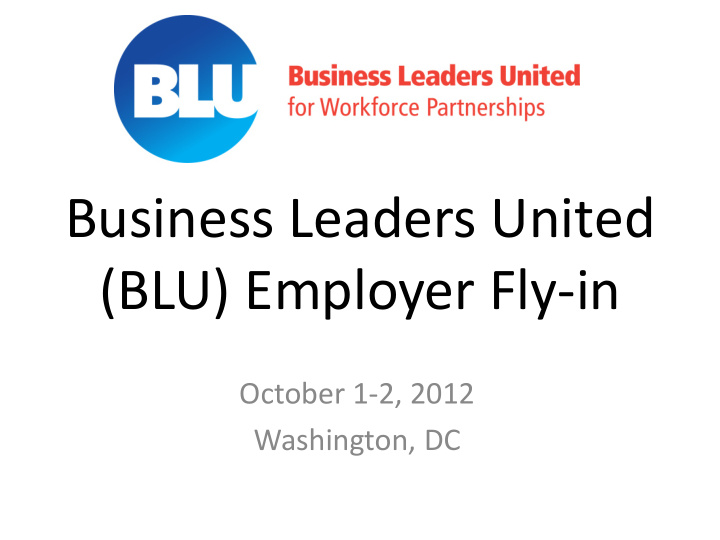



Business Leaders United (BLU) Employer Fly-in October 1-2, 2012 Washington, DC
The Politics of it All: The Ridiculous but True Story of How Washington Ground to a Complete Halt www.nationalskillscoalition.org/blu
Where are We Now? • Washington totally focused on the elections • Congress adjourned mid-September (earliest since 1960) • Both sides rolling the dice that they will have stronger hand post-election www.nationalskillscoalition.org/blu
What Did Congress Finish Before the Election? • Only one major item: pass 6-month Continuing Resolution (CR) • Necessary because Congress failed to complete regular appropriations process • Keeps basic government functions running through March 2013 • Does not impact sequesters www.nationalskillscoalition.org/blu
What Will Congress Do After the Election? • Election will determine how much gets done during lame duck If Obama wins, issues resolved in lame duck If Romney wins, Congress will likely push issues into next year www.nationalskillscoalition.org/blu
Crystal Ball: 2012 Congressional Elections • Democrats currently hold 3 seat majority in Senate 23 Democrats up (10 originally seen as vulnerable, although landscape rapidly shifting) 10 Republicans up (3 seen as vulnerable) • Republicans hold 24 seat majority in House Vulnerable seats a mix of Rs and Ds www.nationalskillscoalition.org/blu
Take Away: Tight Margins and Hard Decisions • Regardless of who wins control, it is likely that there will be tighter margins in both houses • The debate will probably look a lot like it does now—neither party will have the ability to completely control the agenda—no magic answers to get us out of the box we’re in • Many hoping some of the political “heat” will dissipate post-election www.nationalskillscoalition.org/blu
The Issues: The Fiscal Cliff (or How Congress Created a Catastrophe) www.nationalskillscoalition.org/blu
Lame Duck! • Major issues will need to be resolved post-election: Sequesters go into effect January 2, 2013 Bush era tax cuts expire December 31, 2012 Government will hit debt ceiling late 2012- early 2013 CR runs through March, but Congress will have to finish FY 13 appropriations www.nationalskillscoalition.org/blu
Lame Duck! • These issues are highly (highly) politicized and ideological • Lots of competing interests (all trying to protect their programs) • Focus on workforce way out of scale for size of the programs www.nationalskillscoalition.org/blu
Issue #1: Sequestration • Triggered by “super committee” failure • Automatic, across-the- board cut (estimates range from 8.2% to more than 12%) • Equally applied to defense and non-defense • In addition to $1T in cuts already applied www.nationalskillscoalition.org/blu
Issue #1: Sequestration • Everyone agrees that sequesters would be catastrophic. No one agrees on what to do instead • Tremendous pressure to undo defense sequesters—potentially at the cost of non-defense programs • Administration and Senate Leadership say they will only accept balanced alternative www.nationalskillscoalition.org/blu
Issue #1: Sequestration • What does this mean for workforce programs? NSC analysis of key programs suggests cut of about $630M in FY 13 and about 3M fewer people served (most conservative estimate) Caps would stay at least at this level through 2021 www.nationalskillscoalition.org/blu
Issue #2: FY 2013 Appropriations • The good news : CR will run through March 2013 Essentially maintains current funding levels CR is “clean” (no policy changes) www.nationalskillscoalition.org/blu
Issue #2: FY 2013 Appropriations • The bad news : $18B gap overall between House and Senate $27B gap for domestic program funding $8.8B gap for Labor-HHS- Education bill www.nationalskillscoalition.org/blu
Issue #2: FY 2013 Appropriations • What does this mean for workforce programs? House and Senate both generally protected workforce funding But the House protected workforce at the expense of other, high-priority programs (Race to the Top, Affordable Care Act, etc.) that Administration will want to restore Huge difference between overall funding levels will have to be made up somehow—workforce programs very vulnerable www.nationalskillscoalition.org/blu
Issue #3: WIA Reauthorization • WIA very much caught up in funding debate • Ed & Workforce Committee Chairman Kline says WIA first bill he’ll bring up next Congress • Reports of some Senators working on consolidation bill www.nationalskillscoalition.org/blu
What Does It All Mean for Workforce Programs? • Extremely important that MoCs understand the impact of cuts in their local community • Your voice as an employer is one of the most powerful tools we have • The time to act is now. By the time this debate is back on the floor it will be too late • Once is not enough. Keep talking to policymakers www.nationalskillscoalition.org/blu
Okay, I’m Convinced! What Should I Do? Deliver the right, key messages: • Reconsider wholesale across-the-board cuts to workforce training programs. • Increase the number of workers trained with federal dollars. Reauthorize, on a bipartisan basis, WIA and related skills programs with a new requirement that states and localities increase the percentage of funds spent on job-directed basic skills and technical training, in order to prepare more workers for waiting skilled jobs; and • Include effective practices called for by employers —a greater focus on industry- recognized credential attainment, expansion of sector partnership strategies, greater support for employer partnerships with colleges and local service providers, and accelerated hiring through on-the-job training. www.nationalskillscoalition.org/blu
Contact Rachel Gragg, Ph.D. Federal Policy Director National Skills Coalition 202-223-8991, ext. 102 rachelg@nationalskillscoalition.org www.nationalskillscoalition.org/blu
Recommend
More recommend